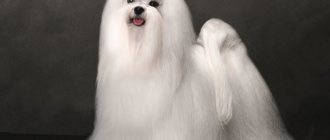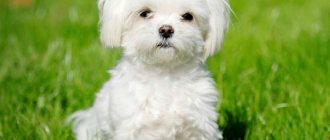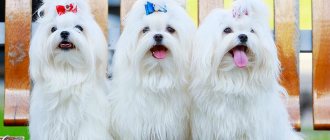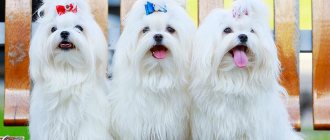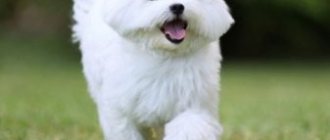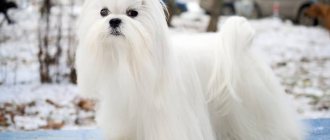The Maltese is one of those miniature dog breeds that causes constant affection in people. Representatives of the breed have a spectacular appearance, small dimensions and a gentle character. They can be called very lively and active pets; they are always cheerful and playful. In this article we will tell you about the characteristics of the Maltese breed, care and maintenance.
Standard and description of the Maltese breed
Height at withers: males 21-25 cm, females 20-23 cm; Weight: 3-4 kg.
- Color: solid, snow-white or pale ivory;
- Eye color: dark ocher;
- Nose color: black;
- General appearance: a small dog with straight and long hair, free and fast movements.
Disqualifying signs:
- aggressiveness;
- cowardice;
- wavy coat;
- spotting;
- eyelids without pigment;
- short tail;
- thorn;
- nose that is not black or completely dyed;
- undershot;
- any color other than the permitted one;
- physical abnormalities.
In the ICF Maltese standard dated January 1, 2016, there is no division by size . Miniature Maltese dogs are not officially recognized. However, there are advertisements everywhere with offers for their sale. Perhaps this is the name of the American version of the breed, whose representatives are distinguished by their small size and delicate body constitution. The second option is not uncommon for small dogs. Sometimes mini puppies are born in a litter of standard puppies.
How to choose a puppy
Maltese: how to choose a puppy
Maltese is a fairly popular breed, which is bred by many breeders. To become the owner of a purebred and healthy puppy, it is better to buy it from an officially registered nursery.
At the time of sale, the baby must already have documents confirming its origin and availability of scheduled vaccinations.
When choosing a Maltese puppy, it is recommended to pay attention to:
- Conditions for keeping mother and puppies. The room where little Maltese live should be clean, warm, light and dry.
- Appearance. A Maltese puppy must fully comply with the breed standard and be similar to its parents. It is important that they have dark shiny eyes, smooth paws, a black wet nose and snow-white, absolutely straight fur. You should not choose the fluffiest puppy from the litter, since an excessively voluminous coat is considered a disadvantage. But a slightly wavy coat may straighten out as the dog gets older.
- Characteristics of puppies. Kids should be friendly, inquisitive, playful and active. It is important that they do not sit, scared, huddled in a corner, but easily make contact and show a healthy interest in everything that is happening.
History of the Maltese
Many believe that the answer to the question of where the first Maltese dogs appeared lies on the surface. This is a misconception, because even experts cannot agree on a common opinion.
The name Maltese comes from the word "malat" . It was often used to refer to islands and localities in the Mediterranean. One version speaks of the Mediterranean, or more precisely of the island of Meleda. Another assumption leads to the city of Melita, which belongs to Sicily.
Historical excavations have suggested that small white dogs with a personality similar to the Maltese lived in Ancient Egypt . In one pharaoh's tomb, archaeologists found a toy in the shape of a Maltese. There are references to them in the annals of the Egyptian people.
The ancient Greeks of that time kept companion dogs similar to lapdogs. Probably due to crossings with foreigners, the Maltese settled in the European part of the continent.
The British noticed the Maltese dogs and appreciated their beauty, intelligence and character. Sailors and traders brought the Maltese to their homes and started breeding. The ancient breed reached its peak of popularity among the nobility of England during the Renaissance. Back then, Maltese dogs were kept by queens and wealthy people.
Thanks to the efforts of English breeders, the breed moved to a new stage of development. Toy poodles and small cocker spaniels participated in the breeding. The work bore fruit in 1864, when the first dogs were presented at an exhibition in Birmingham. After a successful performance, the Maltese was recognized as a breed. In 1873, cynologists in England founded the Maltese Club, although patronage was assigned to Italy.
Maltese dogs arrived in the Russian Empire no earlier than 1812. The highest military ranks of the French army took their snow-white pets with them. Failures forced them to leave the dogs at the sites of destruction. Soon the French dogs found new homes, but lost their breed due to crossings with other dogs.
In the 20th century, the Maltese was not forgotten. This numerous breed is recognized by cynological organizations in Europe and America. Thousands of fans continue to work on improving the Maltese breed.
Temperament and character
Despite their sophistication and light weight, Maltese dogs are able to accompany their owner in various situations, gain new knowledge and discover the world.
Positive qualities of the Maltese:
- Mobility;
- Tenderness;
- Intelligence;
- Devotion;
- Playfulness.
Negative qualities:
- Vulnerability;
- They don't like loneliness.
Dog and man
Maltese are sensitive dogs , they can play for hours, and when a person gets tired, they slow down and adapt to the owner. This character trait and comfort in living together defines a companion dog.
The Maltese dog is suitable for an elderly couple, a responsible teenager and lovers of beauty. The only caveat is difficult grooming . If a person has two to three free hours a week to wash and thoroughly comb their pet, then the Maltese is the best option.
For this breed, the preferred living conditions are an apartment or a private house. They will not survive on the street for two reasons: they will freeze, and they will suffer from lack of attention. In addition, a good-natured disposition does not allow one to respond to offenders as they deserve.
The Maltese dog will not cause damage to things and repairs in the apartment. These proud animals are meant for humans and live up to expectations. They are loyal to children and other animals, but may be jealous of new family members and pets.
Taking care of your health
The Maltese has a fairly strong immune system, but the breed is also susceptible to various diseases.
Most often, pets suffer from:
- glaucoma;
- retinal atrophy;
- blindness;
- blocking of tear ducts;
- heart defects;
- deafness;
- "trembling syndrome"
Maintenance and care
Walks
In winter, Maltese dogs get cold because they have no undercoat. Long hair does not protect from the summer heat. In hot weather, such pets are often given bath treatments and provided with coolness and shade.
Contrary to popular belief, Maltese dogs love to walk and need daily walks just as much as their larger counterparts.
You can train a dog of this breed to make do with a diaper or litter box, but fresh air is necessary for the pet’s well-being. Half an hour walks twice a day are enough.
The Maltese is dressed in overalls and boots in winter. Shoes protect the delicate skin of the paws from reagents and cuts from ice. For exhibition specimens with long hair, such precautions are mandatory.
Feeding
An approximate diet for a puppy consists of the following products:
- Boiled or raw meat (beef, turkey, chicken);
- Vegetables;
- Dairy products;
- Fruits .
The puppy is gradually accustomed to such food. The first feeding of the Maltese dog with natural food is at 2-3 weeks. The first to taste is a tiny piece of meat, then cottage cheese with kefir. A one-month-old puppy is fed 5-6 times a day. From 2 months they switch to 4 meals a day. By 6-7 months the dog is fed 2 times a day.
Food ratio for an adult Maltese :
- Meat – 50%;
- Fruits – 25%;
- Vegetables – 25%.
There are rules for feeding dogs with white fur. To maintain purity of color, foods that change shades . These include:
- Sea kale;
- Carrot;
- Liver.
In most cases, dogs stain their fur with food, but seaweed enhances the red color. If the lap dog has an ivory color, it may become stronger with frequent use.
Chicken, red fruits and vegetables are strong allergens , and Maltese are susceptible to them. After introducing a new product to food, it is worth conducting an experiment and observing the pet’s reaction. The first sign of an allergy is watery eyes, itching and irritation on the skin.
Special ready-made food is selected for Maltese dogs. They should be easily digestible, improve the condition of the coat and be hypoallergenic . Breeders recommend including fish oil, vitamins and minerals for the coat in the natural diet.
Grooming and grooming
Many people get Maltese dogs because of their unearthly beauty. Wool is an indicator of health and grooming. Washing Maltese dogs takes a lot of time. To care for the coat you will need:
- Shampoo for white dogs;
- A mask that does not weigh down the hair structure;
- Balm that adds light shine and silkiness;
- Leave-in products with a smoothing effect;
- Conditioner for daily combing and moisturizing;
- Powder or other whitening agent.
Tools:
- Sharp scissors for grooming;
- Wide-toothed comb;
- Massage brush;
- Hairdryer or compressor.
The products are applied in the specified order. Lather the shampoo twice. Wash your Maltese once every 10 days . For an exhibition copy, the period is reduced to 7 days. Comb with moisturizing conditioner - daily . Use a wide-toothed comb to carefully separate the fur and go through it, without pressing or tugging. A massage brush is needed at the final stage. The powder is applied after the wool is dried and styled.
For exhibitions, the snow-white coat of Maltese dogs is grown long enough to reach the ground. Dry in the direction of growth, the cover should be uniform, without partings or shreds.
During the period between exhibitions, the wool is wound onto curling irons . They do this with dogs 7-8 months from birth. Papillots are made from tissue paper. Individual curls are laid on them in layers and secured with an elastic band. Before the procedure, the coat is moisturized with oils or sprays that are suitable for the dog. Re-twist 1-3 times a week. Maltese with thick hair that is not prone to tangling can do without hair curlers. Between procedures, the dog is washed and dried.
Grooming an exhibition specimen requires the hand of a master. In this case, the length is left to the maximum, trimming only the ends. They also cut the hair in the groin of male dogs, under the tail and shape the paws. Seasonal pet haircuts are suitable for pets. The new look of the pet depends on the imagination of the owner and groomer.
Puppies are accustomed to all of the above procedures from 3-4 weeks . By treating your Maltese affectionately, you can achieve complete mutual understanding and enjoy washing and grooming.
Interesting fact: the Maltese's hair grows quickly, like human hair, so it will need to be cut frequently.
Yellow smudges appear around the Maltese's eyes . These tear ducts are removed with a special product. After moistening a cotton pad in it, carefully apply it to the fur and remove stains with light movements. To prevent your eyes from running, it is advisable to review your dog’s diet and visit a veterinarian. Overgrown claws are trimmed with special tweezers. A Maltese dog's teeth are cleaned in a clinic.
Nutrition
In order for the Maltese dog to develop properly, to be full of strength and energy, and to maintain health for many years, it is best to give it special dry food. Its manufacturers guarantee the balance of all components and compliance with all the necessary proportions of microelements and vitamins in it.
It is advisable to consult a veterinarian and check reviews about the manufacturer before choosing food. In addition, it must be selected according to age and individual characteristics.
But there are dog owners who do not trust dry food and prefer to prepare food for their pets themselves. In this case, the main thing is not to forget to add the necessary minerals and vitamin complex to the dog’s diet. This will help keep your dog in great shape.
Maltese dogs can be given poultry, beef, chicken eggs and various vegetables. Mixes and mixtures can be made from these ingredients. In addition, fish is sometimes introduced into the diet, which must be pre-cooked. Various cereals are also served with fish. For example, buckwheat or rice.
In addition to what to give your dog, you also need to know how to do it correctly. It is not recommended to keep a bowl of food on the floor all the time, that is, put a portion on the floor. After eating, he cleans up and washes himself. Next time everything is repeated again.
In addition, it is better not to leave food in the dog’s plate in reserve. Meals should be on a schedule. Adults need to break their food intake into 2 stages. At the same time, in the morning, porridge is given with milk, water or meat broth with the addition of pieces of chicken or beef.
Maltese puppy
In the evening - mixes of meat and vegetables, as well as eggs or fish. Portions should be small so that the dog does not gain much weight. Since this will have a bad effect on the functioning of her internal organs. In addition to standard dishes, the Maltese dog can sometimes be rewarded with treats. You can buy them in specialized stores.
Education and training
The Maltese takes 59th place on psychologist Stanley Coren's list. Next to her are a Brussels Griffon, an Italian Greyhound and a French Bulldog. They are in the group of dogs whose learning abilities are below average . During research for them, the command was repeated from 40 to 80 times, and they achieved execution in 30% of cases and above.
The Maltese is taught simple commands that are necessary in everyday life. The companion must be obedient, so it is better not to spoil small dogs. You cannot use physical methods in training, scare or harshly punish your pet.
The Maltese easily recognizes intonations and emotions. You can take this into account and teach your dog to respond to quiet voices and gestures. With such a lapdog, a walk will be a pleasure.
If you are training your Maltese to eat treats, it is best to do the training before feeding. The breed does not have an increased appetite; because of this, treats are carefully selected to interest the dog.
What is the price
You can buy a puppy “for yourself” with documents from a professional nursery for 20,000-25,000 rubles. If you are thinking about exhibitions, then in Moscow such a puppy will cost from 50,000 rubles. Some breeders bring their studs from South Korea. There prices start from 300,000 rubles. Korean dogs are distinguished by a shortened muzzle, wide-set large eyes, and a more compact body. With such costs, of course, breeders will keep high prices for Korean-type Maltese.
Video about the characteristics of the Maltese breed:
Breed photo
A selection of photos of Maltese dogs.
